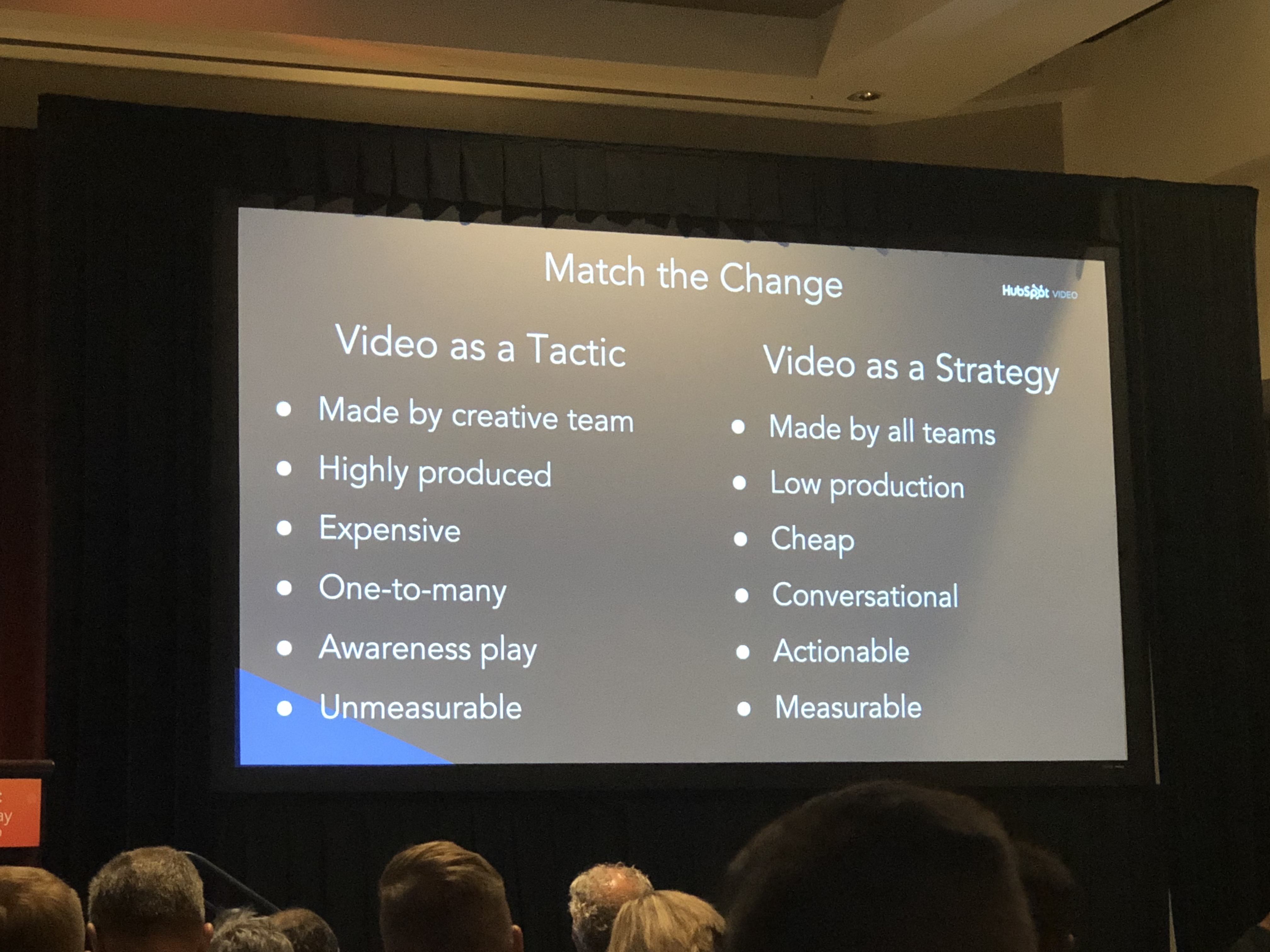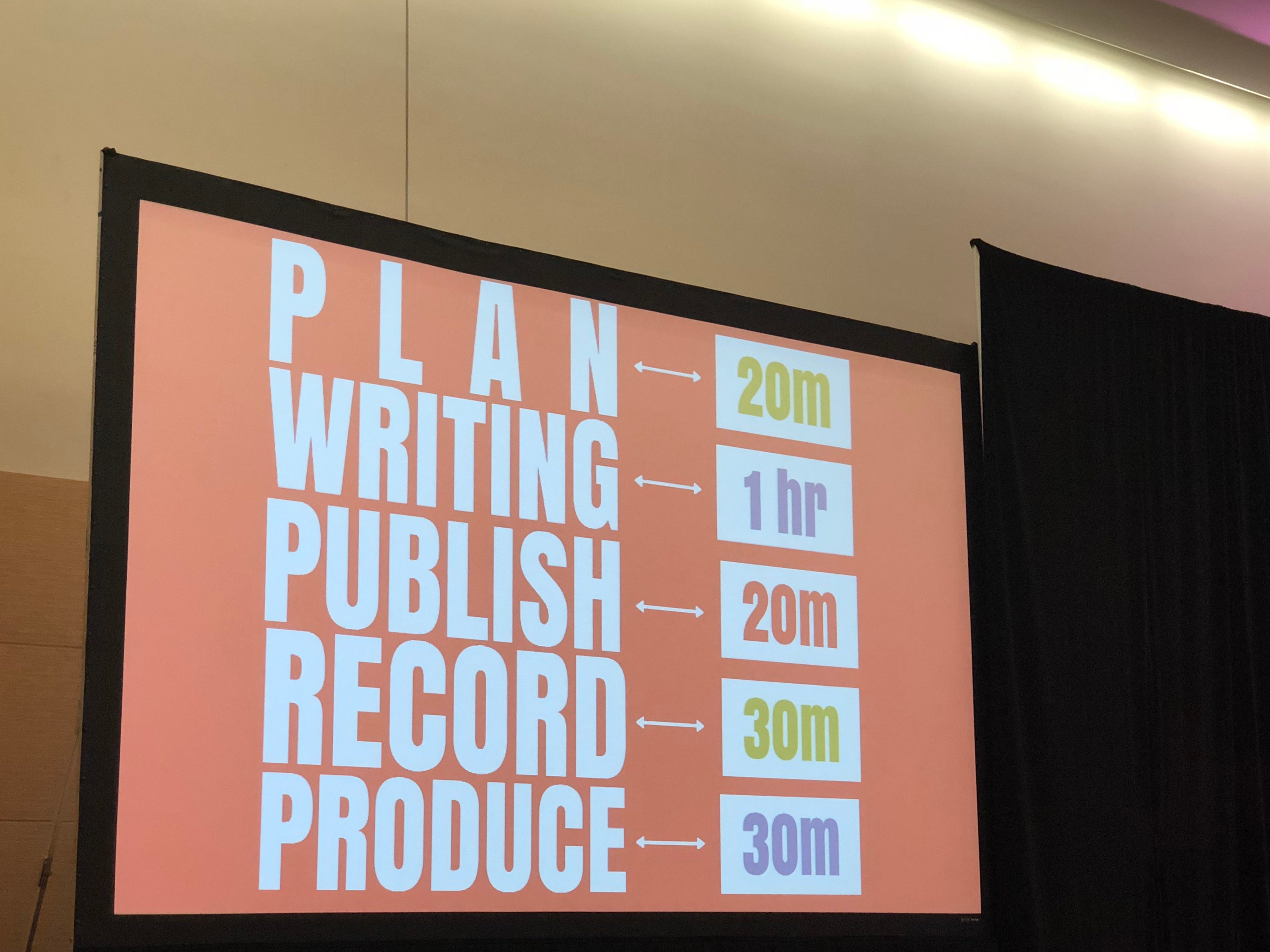I'm an inbound writer, so my job is to create content. For nearly every industry, that content now includes video. As a result, I went to almost every single video marketing session at this year's Inbound. It was critical to absorbing more knowledge about how people are using video marketing, despite having significant experience in video myself.
However, by the end of the week, I was a little discouraged by what I heard. Despite that fact that 87% of online marketers are using video marketing, there's still a lot of misinformation out there.
It's surprising, as nearly every prominent video marketing agency had a session this year. While speakers were spot on about the value of video marketing, when it came to the process, price, and execution, a lot of their advice began to fall apart.
What Almost Every Video Marketing Agency Got Wrong
Remember when content marketing and social media became main players in the digital marketing space? At first, marketers were resistant to adopt the new approaches, but before long, everyone was doing it. Perhaps irresponsibly, most people quickly branded themselves as experts. As a result, some companies got poor guidance about frequency, cost, and process.
We're at the same place with video. Video has been around for a few years now, so most of us understand why we should do video and standard best practices. Now, we need to focus on how to produce high-quality, intriguing videos that deliver ROI. That means getting industry-specific, doing more research about your target market, and getting inventive (notice I said inventive and not creative.)
Here’s an overview of the video marketing advice given at Inbound this year, and my take on whether or not it's accurate.
#1. Insourcing Video Is Too Expensive
In my opinion, the first decision you need to make about video content is whether you need to insource, outsource, or a mix of both. A lot of speakers didn't touch on how this decision should be made and threw out numbers and projections about how much videos could cost. But without that decision made up front, it's nearly impossible to project the cost.
20 Ways to Incorporate Video Content into Every Stage of the Buyer's Journey, Chad Rogers, Lemonlight
Use a ballpark figure of monthly spend to start, including what you can afford concerning time, production, crew, and strategy.
With that figure, evaluate the potential to insource, using a few key areas to guide your thinking:
- Staff - Determine which team members will work on your videos, their availability, and how much of that time you can afford to spend on video efforts (use their hourly rate.)
- Strategy - You can weave your video strategy into your overall marketing objectives (and you should), but you will still need time to research the types of videos your customer wants, where the videos will fit into your buyer journey, and which types of video will best support your goals.
- Materials - At the very least, you will need a web camera or video camera, video editing software, a reliable location to shoot, and a charismatic speaker to insource video.
- Training - Unless you have someone in-house with experience shooting and editing videos, you will need to invest in some training for your staff.
Lastly, consider the risk of insourcing. If you don't get it right and invest a lot of money, you'll be back where you started. However, I don't feel it's impossible and could be better for people starting out with a lower budget.
If you lack expertise in any of the above areas, it may indicate that outsourcing to a video marketing agency or experienced freelancer may be the better choice.
#2. Scripts Must Be Extremely Detailed
While in-depth, approved scripts are appropriate for How-To, Product, and explainer videos, more off-the-cuff or candid videos may not need them. A stuffy script for fun or casual video can detract from the tone and overall feel, and you may also lose opportunities for improvisation.
I would base the depth and detail of your script on a few things:
- The type of video you're making. A video that's going to be an introduction to a team member or a sales follow-up can use a loose script, talking points, or an outline.
- The personality and demeanor of the host or narrator. If the team member in the video is charismatic and confident, they can probably introduce themselves in a video without needing lines.
- Your typical approval process. If you work at an organization with a lot of decision-makers, it may be less risky to get detailed scripts approved through the right channels.
It's also important to note the difference between a script, and a production outline or storyboard. You need documentation about the specific shots and footage you need to shoot for every video. Otherwise, you may burn through your budget taking too many or too few shots that won't deliver the kind of video you were expecting.
#3. You Must Buy A Camera
You shouldn't decide to buy a camera until you commit to insourcing your videos. Otherwise, you may get an expensive camera only to outsource components of your project or even hand off the entire thing. The anxiety, worry, and purchase of a camera will have been unnecessary.
Even if you decide to insource, unless you have significant experience with cameras, I would recommend renting a camera before purchasing one. You need to make sure the camera is easy enough to use and fits your needs.
Additionally, after starting with video marketing, you may discover you need to outsource because of the difficulty or time required for video production. If you buy a camera before determining if your team is capable of producing videos on an ongoing basis, that's a few thousand dollars that may go to waste.
#4. You Need A Studio
I agree with this one. If you're insourcing your video production or even having a videographer come to shoot in person, you need a space to record videos. The alternative is trusting a freelancer a hundred percent on selecting a location, which is a risk I don't think is worth taking. In a worst case scenario, if you let someone else choose the lighting and acoustics they prefer, you may spend a lot of time on reshoots and edits.
If you're in an office, you can use a private room or conference room with plain colored walls as a location. In the case that your office is too loud or doesn't have any spaces like that, you can find a co-working space, room rental, or potentially, an Airbnb. You should select something you can rent in the future. Choose carefully and inquire about availability.
Now, if you're outsourcing to an agency, they may handle the space entirely. In that case, I would still recommend asking for a photo or a quick video clip of how the studio space looks. You want to make sure it has decent light and matches the look and feel of what you're trying to achieve. If you get this information up front, it can prevent massive reshoots.
#5. Every Video Will Cost At Least 2k
Without context, there are way too many components to throw out an average price tag of a video. It would be similar to telling someone the cost of a car based on their desire to get one.
To price videos, you need to:
- Determine if you will insource or outsource (or a mix.)
- Ask decision-makers the right questions to determine specific needs and expectations.
- Set a goal for your videos.
- Decide how you need to tell the story.
For the most accurate pricing, it's important to determine these things first. For instance, if you want to generate videos describing the uses of your product, a video with a screen share and a narrator will cost significantly less than a custom animation that walks through all of the features.
If you can pinpoint the various uses, and how much the production value matters (and it does), you can begin to break the cost down.
#6.iMovie Is For Chumps
I don't like when marketers fail to recognize their marketing privilege. While some agencies have the budget and experience to throw down for the most expensive tools, some companies and small businesses don't have the resources yet. Video can be costly. If you go into video thinking that it has to be expensive to be effective, you can end up putting off video completely.
I use iMovie for videos all the time. If you shoot high-quality footage with great sound, iMovie can provide similar value to other video editing platforms. It's an excellent resource for beginners who are still learning how to edit and adjust clips for the first time. After you become a pro, you can upgrade to Final Cut Pro or more expensive software.
#7. You Need To Post Video Everywhere
Once you have a video edited and ready to go, it's tempting to post it anywhere and everywhere your customer can see it. However, that's not the way to generate ROI from your video assets. You wouldn't put all of your team bios, pricing information, and lead magnets everywhere, and you should treat video the same way.
Conquering Consistent Content: Tools & Tactics to Become a Prolific Blogger, Podcaster & Broadcaster with Colin Gray.
You get the most value from video by inserting it at critical points in the buyer journey. If you can determine how video can best support each stage, you can create a more strategic distribution and edit your video appropriately for each channel. I'd recommend revisiting your buyer journey or customer journey map for a clearer perspective.
Video Takes Confidence
My favorite quote from Inbound was from George B. Thomas, who also had one of the best video sessions of the conference. If you go into video thinking it will be hard, it will be hard. But if you go into video thinking it will be easy and fun, it can be. It's like developing any other skill. It takes patience, discipline, and curiosity to create a process that works for you. When done correctly, video can be flexible and meet your specific needs, expectations, and budget.
However, the learning curve can be intimidating. In that case, you may want to find a video marketing agency to start creating higher quality assets sooner. Many of the agencies at Inbound had impressive portfolios and credible approaches for producing video content. However, if you want a growth team that can evaluate how video will support your existing initiatives, we might be a great match. Check out our Game Plan offer to start.






